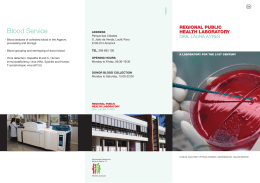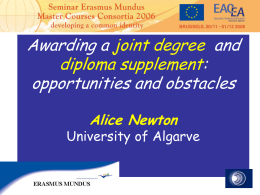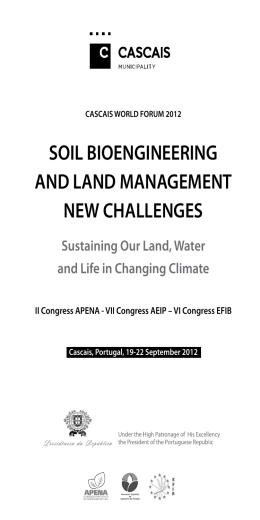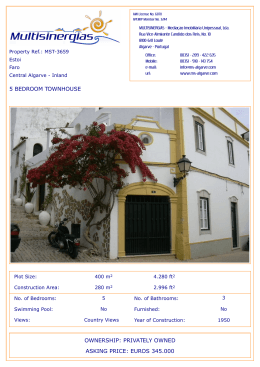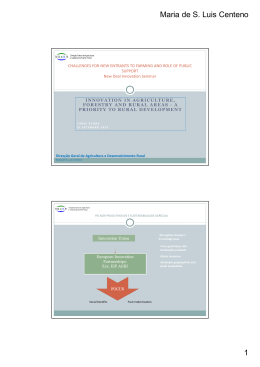CCDR Algarve - A monitorização da sustentabilidade no Algarve e os indicadores de paisagem e de biodiversidade Faro, 4 de Abril de 2005 APPLYING NIJOS LANDSCAPE INDICATORS TO THE RIBATEJO E OESTE REGION 1 By Rui Rosário (INIAP), Ana Antunes e Isabel Escada (GPPAA) Abstract The presentation reviews some results of a research project ended in 2001 at the National Institute of Agrarian and Fisheries Research on the first design of an agro-environmental information system prototype. The project integrates different data contents and formats, namely 500 segments of 25 ha that make up the area frame sample (1% sampling rate) of Ribatejo e Oeste region. It uses information obtained by applying photo interpreting and vectoring techniques to the digital orthophotomaps of each segment. The possibility of obtaining thematic maps at different infra-regional (municipality) levels was quite successfully tested using several landscape indicators. Introduction Land use and management planning requires knowledge about the different types of soil occupation and the way they evolve through time. Therefore, there is a need to improve methods, technologies and knowledge that support the collection and processing of this type of information, which is implicitly associated with spatial attributes. The efficiency in processing georeferenced information is a requisite to identify and analyze the occupation of the different territorial units. These suffer pressure from decisions sometimes contrary to the increasing concerns regarding the preservation of natural resources and of the farm related historical heritage, which are dominant in present societies. In order to monitor the pace of change and the complexity of soil occupation, as well as changes in landscape or in other environmentally relevant features, it is necessary to have technologies containing spatial references that can be automatically processed. The research project at the origin of this paper was framed by this set of concerns. It was meant to test the use of GIS to produce information associated with soil occupation based on geographical and statistical information available in Portugal and integrating new data obtained by photo interpreting already existing digital orthophotomaps. This would contribute to the development of an information system prototype to be used as a tool in the agro-environmental arena in Portugal. The strategy chosen to integrate the latter type of data into the system was based on the launching of a sample of territorial sections (25 ha square segments), established on the basis of statistical criteria, where information has been gathered using photo interpretation techniques previously tested through field work. This work stage enabled the construction of a support infrastructure to integrate the different type of georeferenced data. This solution was designed assuming that it would be extended both thematically and geographically. After this first step, it became possible to test the use of a geographical system created to approach certain farm related environmental issues, namely regarding soil occupation and the landscape it gives rise to. Phenomena such as plot splitting, occupation heterogeneity and diversity, urbanistic pressure under its multiple forms, the location of crop productions or of the main types of land cover are crucial elements in the landscape and took up this work stage. 1. Project outline and methodology Since the project’s main target is to obtain a multiple-purpose information system (multiple themes), a non-stratified aligned systematic sample was chosen. The process used to obtain the sample was based on a methodology that would allow a uniform coverage of the region. Therefore, a 25 hectares square segment sample was launched (fixed geometry). 1 Rosário, Rui; Ana Antunes e Isabel Escada, 2001. Elementos Paisagísticos do Ribatejo e Oeste, Estação Agronómica Nacional, Instituto Nacional de Investigação Agrária. 1 CCDR Algarve - A monitorização da sustentabilidade no Algarve e os indicadores de paisagem e de biodiversidade Faro, 4 de Abril de 2005 The direct observation of the different soil occupations in “land parts”, without any intervention from farm holders, was also chosen. In order to launch the sample, a geographical area sufficiently heterogeneous in terms of landscape was defined to guarantee the adequacy of the “data model” to the different geographical situations in mainland Portugal. For practical reasons the Ribatejo e Oeste Agricultural Region was chosen. 1.1. Methodology used to extract the sample The following steps were taken to extract the sample: Delimitation of the geographical area of Ribatejo e Oeste on the 1/250 000 military chart (Instituto Geográfico do Exército). This chart includes a ten-kilometer grid. Each 10x10 km block was divided into 400 500x500 m small squares. In order to standardize the sample coverage, 4 points were selected on each block at a 5 km distance from each other. These 4 points were systematically represented on all the blocks that make up the grid overlaying the representation of the geographical boundaries of the region. The points elected occupy always the same relative positions on each block. Each point represents the center of a 500x500 m square, called “segment”. The set of segments thus obtained make up the sample to be used in the research. The sample is made up of 483 segments of 25-hectare each, at a 5 km distance from each other. Area sample = 483 seg x 25 ha ⇒ 12 075 ha Region area = 1 205 260 ha Sampling rate = 1% (see Map 1 for a regional decomposition) Map 1 – Sampling rate per municipality Ferreira do Zezere Vila Nova de Ourém Tomar Nazaré Sardoal Alcobaça Torres Novas V. Nova da Barquinha Entroncamento Alcanena Constância Caldas da Rainha Abrantes Gavião Golegâ Óbidos Peniche Santarém Rio Maior Bombarral Chamusca Lourinhã Alpiarça Cadaval Azambuja Torres Vedras Cartaxo Almeirim Alenquer Salvaterra de Magos Sobral de Monte Agraço Arruda dos Vinhos Mafra Vila Franca de Xira Coruche Benavente Loures Sintra Amadora Lisboa Cascais Montijo Alcochete Oeiras Montijo Moita Almada Barreiro Palmela Seixal Setúbal Sesimbra 1.2. Integration of raster, vectorial and alphanumeric information The GeoWorkspace created to meet the project’s targets includes two types of warehouses: • Warehouses created outside the GIS environment, in CAD format and read-only type: 1. Name of the Municipality 2 CCDR Algarve - A monitorização da sustentabilidade no Algarve e os indicadores de paisagem e de biodiversidade Faro, 4 de Abril de 2005 2. Number of the Segment The warehouse created in the GIS environment, in Access format and read/write type. In this warehouse 3 feature classes (objects) were defined, with an area type geometry: 1. “Municipality” feature class 2. “Segment” feature class 3. “Crop Occupation” feature class • Each feature class has both graphic and alphanumeric attributes. The alphanumeric attributes selected for each feature class were targeted to characterize them. After establishing the different links to the data bases, besides the administrative chart of the region, the location of the sample segments is also obtained (Figure 1). By means of photo interpretation techniques (monoscopic interpretation of screen images), the plot structure of each segment was identified. This structure was defined taking into account the type of occupation of the corresponding area (classification of soil occupation). After identifying the different homogeneous occupations in a segment the vectorization was performed. Figure 1 –Administrative chart of Ribatejo e Oeste, segment location and example of survey to the Municipality Feature Class (Coruche municipality) In order to perform this work, it was necessary to establish parceling criteria and definitions regarding the different soil occupations observed in raster images (digital orthophotomaps). Therefore, the following soil occupation classes were defined: - Forest and brushwood (FL); Open Land (TL) Open Forest Area with Agriculture or Understory (TLS) Permanent Crops (CP) - subdivided into the following categories: Permanent Crops – orchards and olive grove (CP_PO) Permanent Crops – vineyard (CP_V) 3 CCDR Algarve - A monitorização da sustentabilidade no Algarve e os indicadores de paisagem e de biodiversidade Faro, 4 de Abril de 2005 - Urban Areas (URB) - subdivided into the following categories: Urban Settlements (URB_POV) Mixed Urban Settlements (URB_MISTO) Buildings (URB_CR) Dams, Lagoons, Weirs, etc. (ALB) Rivers, Estuaries, etc. (AGU) Ocean (MAR) Highway (AE) Asphalt Road (EST) Once the photo interpretation process was concluded, the second stage of the project was initiated, having has a main target to check the methodological aspects used in photo interpretation. Following the second stage, photo interpretation data was compared with field data. In order to perform this work, four evaluation criteria were established: Plots with consistent classification and parceling; Plots with classification deviations; Plots with parceling deviations; Plots that due to differences between the time when aerial photographs were taken and field data was collected changed their occupation type – update. Figure 2 - “Crop Occupation” Feature Class and Alphanumeric Data The analysis underlines the following: in a total of 520 plots obtained by direct observation, 235 were correctly classified and outlined, that is, accuracy reached 45.2%. In 54.8% of the plots there were deviations (285 plots); overall, there is a high percentage of parceling deviations (31%), which can be justified by the detail level used in photo interpretation; 4 CCDR Algarve - A monitorização da sustentabilidade no Algarve e os indicadores de paisagem e de biodiversidade Faro, 4 de Abril de 2005 the analysis made to the efficiency of photo interpretation by large groups of soil occupation (TL, AF, CP, FL, URB, RIO+ALB) reveals that the highest percentage of correct plots is found in AF and TL (93% and 81%, respectively); The groups with the highest percentage of deviations are FL (43%), CP (31%) and URB (21%). 2. Results An indicator may be defined as a parameter that provides information about a certain aspect of reality, describing the state of a certain phenomenon, regarding some particular feature or an aggregated set of features. Indicators somehow enable quantified and simplified accounts of the reality, being normally associated with a specific aspect of that reality. From a methodological point of view, indicators require a consistency level capable of guaranteeing a value confrontation between territories (inter-regional or international) and the possibility of monitoring the phenomenon they represent in the long run. Landscape indicators can become valuable tools to detect evolution trends in landscape changes with the advantage of enabling comparisons both in time and in space. Identifying landscape changes in due time may be determinant in decision making, in terms of dissuading negative actions or encouraging environmentally positive practices. As mentioned before, to describe, compare and evaluate landscapes by means of indicators is a hard task. For instance, comparing values of landscape diversity at national level may be inadequate. However, moving to a regional or local level, these indicators become reliable and start making sense. One way to approach and integrate this type of questions consists in developing landscape typologies. These should enable comparing and evaluating evolution trends between similar landscape types, between spaces and within a certain territory. Specific landscape types may be identified and measured at an international level. The following indicators stand out from the different landscape indicators currently used: A). Soil occupation indicators First of all, the plot structure in each segment was identified, using photointerpretation techniques. This structure was defined taking into account the type of occupation of the corresponding area (soil occupation classification). Map 2 –“Permanent Crop_Vineyard” Soil Occupation per Municipality Ferreira do Zezere Vila Nova de Ourém Tomar Nazaré Sardoal Alcobaça Torres Novas V. Nova da Barquinha Entroncamento Alcanena Constância Caldas da Rainha Abrantes Gavião Golegâ Óbidos Peniche Santarém Rio Maior Bombarral Chamusca Lourinhã Alpiarça Cadaval Azambuja Torres Vedras Cartaxo Almeirim Alenquer Salvaterra de Magos Sobral de Monte Agraço Arruda dos Vinhos Mafra Vila Franca de Xira Coruche Benavente Loures Sintra Amadora Lisboa Cascai s Montijo Alcochete Oeiras The following definitions apply: Montijo Moita Almada Barreiro Palmela Seixal Setúbal Sesimbra 5 CCDR Algarve - A monitorização da sustentabilidade no Algarve e os indicadores de paisagem e de biodiversidade Faro, 4 de Abril de 2005 “Permanent Crop_Vineyard” – areas occupied with vineyard, which are easily distinguished from other permanent crops (orchards and olive groves) in photointerpretation, particularly when they are orderly planted; “Agro-Forestry” – areas normally occupied with forest, with a tree density per hectare that allows using almost the total area for temporary crops or permanent pastures. It should not be forgotten that plot is an area within a segment, continuous in terms of occupation, regardless of containing two or more physical land units. Soil occupation class is a specific type of soil covering that happens in a certain area. The occupations “Permanent Crop_Vineyard” and “Agro-Forestry” were chosen to characterize this indicator. Regarding “Permanent Crop_Vineyard” (Map 3), there are two areas that provide a major contribution to the region: - Littoral center (12 municipalities); - Southeast (Palmela and Montijo municipalities). In the remaining municipalities this occupation is virtually nonexistent (below 5%). The “Agro-Forestry” occupation increases as you move inland as shown on Map 3. Around 20% of the area, both in the region and in the sample, is represented in the class that has the largest contribution of this occupation (48%-63%). Map 3 –“Agro_forestry” soil occupation per municipality Ferreira do Zezere Vila Nova de Ourém Tomar Nazaré Sardoal Alcobaça Torres Novas V. Nova da Barquinha Entroncamento Alcanena Constância Caldas da Rainha Abrantes Gavião Golegâ Óbidos Peniche Santarém Rio Maior Bombarral Chamusca Lourinhã Alpiarça Cadaval Azambuja Torres Vedras Cartaxo Almeirim Alenquer Salvaterra de Magos Sobral de Monte Agraço Arruda dos Vinhos Mafra Vila Franca de Xira Coruche Benavente Loures Sintra Amadora Lisboa Cascais Montijo Alcochete Oeiras Montijo Moita Almada Barreiro Palmela Seixal Setúbal Sesimbra 6 CCDR Algarve - A monitorização da sustentabilidade no Algarve e os indicadores de paisagem e de biodiversidade Faro, 4 de Abril de 2005 B). Biodiversity indicator By aggregating physical plots with the same type of soil occupation, the number of different occupations is obtained, that is, the number of occupations that characterize a segment. For a given area, Diversity is calculated as follows: NO NS Diversity = NO – total number of different occupations NS – total number of segments Analyzing this variable at the municipality level (Map 4) shows that littoral municipalities have the highest diversity, which is less obvious when moving inland within the region. Approximately 48% of the municipalities are included in the class of 4 to 5 occupations per segment, only 6% having one occupation per segment. Map 4 – Diversity per Municipality Ferreira do Zezere Vila Nova de Ourém Tomar Nazaré Sardoal Alcobaça Torres Novas V. Nova da Barquinha Entroncamento Alcanena Constância Caldas da Rainha Abrantes Gavião Golegâ Óbidos Peniche Santarém Rio Maior Bombarral Chamusca Lourinhã Alpiarça Cadaval Azambuja Torres Vedras Almeirim Cartaxo Number of occupations per segment Alenquer Salvaterra de Magos Sobral de Monte Agraço Arruda dos Vinhos Mafra Vila Franca de Xira Coruche Benavente Loures Sintra Amadora Lisboa Cascais Montijo Alcochete Oeiras Montijo Moita Almada Barreiro Palmela Seixal Setúbal Sesimbra C). Landscape Indicator “Edge” is based on the length of the line that separates different soil occupation classes. “Edge Density” (in m/ha) or alternatively the Perimeter/Area ratio equals the length (m) of all the limits of the different plots. This index is calculated as follows: ED = E A E = Total perimeter of the plots (m) A = Total area of the reference unit (ha) 7 CCDR Algarve - A monitorização da sustentabilidade no Algarve e os indicadores de paisagem e de biodiversidade Faro, 4 de Abril de 2005 The ED index, besides taking into account the complexity of the plots shape, expresses the spatial heterogeneity of landscape fragmentation. Its highest values (Map 5) occur by the region’s littoral strip. Chart 2 indicates the distribution of the segments absolute frequencies by class of perimeter/area ratio calculated for the region. The class with the highest absolute frequency (168 segments - 35% of the sample) is the 128-255 class. In this case, there are also 45 sample segments (9%) with values for this index above the maximum value by municipality. This class (>510) is also shown on Chart 1. Map 5 – Perimeter/Area ratio per Municipality Ferreira do Zezere Vila Nova de Ourém Tomar Nazaré Sardoal Alcobaça Torres Novas V. Nova da Barquinha Entroncamento Alcanena Constância Caldas da Rainha Abrantes Gavião Golegâ Óbidos Peniche Santarém Rio Maior Bombarral Chamusca Lourinhã Alpiarça Cadaval Azambuja Torres Vedras Cartaxo Almeirim Alenquer Salvaterra de Magos Mafra Meters per hectare Sobral de Monte Agraço Arruda dos Vinhos Vila Franca de Xira Coruche Benavente Loures Sintra Amadora Lisboa Cascais Montijo Alcochete Oeiras Montijo Moita Almada Barreiro Palmela Seixal Setúbal Sesimbra 3. Conclusions The main target of this research project was to outline and test a prototype for an information system directed to landscape issues, assessing its ability and flexibility to be thematically and geographically extended. It should be stressed the need and interest in approaching this type of issues by resorting to more or less extensive territory breakdowns, according to the objective of the study. Simultaneously, considering our initial stage of research in this field, it is important not to hinder the extension of the model to new variables. This is an important characteristic, given the anticipated increase in research activity in this field for the next years. Therefore, the flexibility and versatility required from an information system in this area are key elements in its future utility. We believe that the results obtained safeguard these two conditions. In addition, the land segment sample used in this work enables generating a potential for collecting data on the landscape structure of the different areas and also a statistical support to monitor different phenomena resulting from soil occupation. These can be implemented by means of field data collection in statistically pre-established sites. It should be noted that the sampling rate used in this work was intentionally reduced to the minimum value considered viable for collecting this type of information. The balance between the number of 8 CCDR Algarve - A monitorização da sustentabilidade no Algarve e os indicadores de paisagem e de biodiversidade Faro, 4 de Abril de 2005 segments, their size and spacing led to a 1% regional sampling rate. The test performed to assess the ability of this work to produce infra-regional results, by breaking down the region into smaller geographical units (municipalities), showed that 54% of the region area and 49% of the geographical units had a sampling rate equal or above 1%. Only two very small mostly urban municipalities did not have any representation. In future work, it might be useful to reinforce this component of the model. A possible solution would be to increase the size of the segments. In previous works made in Portugal, 100-hectare segments were used, which would imply, in this case, a four times higher sampling effort. However, it is necessary to adequate segment size to the landscape structure where they are applied. Therefore, it could make sense to work with different sized segments according to the degree of fragmentation of the land and to the diversity of its soil occupation. This approach also enables to tackle some of the issues raised regarding the quality of the estimates produced, namely in terms of their scattering. The coefficient of change of the latter is quite sensitive to occupation frequency and to the contribution of that occupation to the analyzed area as a whole. This way, increasing segment size may lead to a direct improvement in the quality of the information produced. Another way to improve the model performance in statistical terms might be to tighten the sample grid, by introducing a new segment at the center of the square formed by the set of four contiguous segments, that is, increasing in 30% the number of segments. This solution would equally enable a more thorough geographical analysis. These sampling developments are made easier since part of the work is based on already existing photographic material in Portugal, made for policy control proposes, which covers the whole territory in a continuous way. Another conclusion is that photo-interpreting techniques are quite adequate when dealing with large groups or categories of territorial occupation. Although some difficulties were found in using this type of solution, for aggregated levels of results the cost/benefit ratio is extremely interesting. The larger the scale of the photographic material, the more efficient the photo interpreting process. This work used orthophotomaps with a scale of 1:10 000. When land is highly fractionated, 1:5 000 or higher scales seem to be advisable. Therefore, the solution created admits two levels of use for the outlined system. The first level, less ambitious in terms of information detail, is solved by means of “office work”, avoiding or considerably reducing field data collection costs. The second level, which requires field data collection, is more expensive, but it is also richer in terms of the data it provides. It should be noted that the results of the abridged version of the system can be regularly updated, whenever the photographic material at their origin is updated. This way, it is possible to monitor the evolution in the soil occupation groups considered at this level, as well as all the variables that can be directly obtained from this material. The application of this methodology to the whole territory enables the production of information unpublished in Portugal at a merely marginal cost, since this solution only requires access to photographic material already available, which is justified and made profitable by other type of actions. The flexibility of the data model created is a crucial element for this second work level. Depending on financial availability, multidisciplinary teams may be sent to the sample sites to collect data. In this regard, a huge work field is left open, only limited by imagination and by the financial ability to implement it. Progress made in researching landscape characteristics and systematizing them into typological groups; monitoring of aspects related with soil quality, erosion risk assessment, water quality; monitoring of farming practices and crop health status; the presence of farm related cultural and architectonic elements and their degree of preservation are some examples of themes that can be approached using this type of methodology and that can be integrated in the solution created. One of the advantages of this type of solution lies in the possibility of integrating several data types in the same structure, enabling a global analysis of the information at later work stages. This is a huge added value in analytical terms, since it allows a more thorough and detailed analysis of the problems that could hardly be obtained by another type of approach. 9
Download


